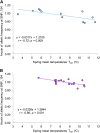Imprints of natural selection along environmental gradients in phenology-related genes of Quercus petraea
- PMID: 23934884
- PMCID: PMC3781976
- DOI: 10.1534/genetics.113.153783
Imprints of natural selection along environmental gradients in phenology-related genes of Quercus petraea
Abstract
We explored single nucleotide polymorphism (SNP) variation in candidate genes for bud burst from Quercus petraea populations sampled along gradients of latitude and altitude in Western Europe. SNP diversity was monitored for 106 candidate genes, in 758 individuals from 32 natural populations. We investigated whether SNP variation reflected the clinal pattern of bud burst observed in common garden experiments. We used different methods to detect imprints of natural selection (FST outlier, clinal variation at allelic frequencies, association tests) and compared the results obtained for the two gradients. FST outlier SNPs were found in 15 genes, 5 of which were common to both gradients. The type of selection differed between the two gradients (directional or balancing) for 3 of these 5. Clinal variations were observed for six SNPs, and one cline was conserved across both gradients. Association tests between the phenotypic or breeding values of trees and SNP genotypes identified 14 significant associations, involving 12 genes. The results of outlier detection on the basis of population differentiation or clinal variation were not very consistent with the results of association tests. The discrepancies between these approaches may reflect the different hierarchical levels of selection considered (inter- and intrapopulation selection). Finally, we obtained evidence for convergent selection (similar for gradients) and clinal variation for a few genes, suggesting that comparisons between parallel gradients could be used to screen for major candidate genes responding to natural selection in trees.
Keywords: Quercus petraea; association tests; bud phenology; candidate genes; clinal variation.
Figures



References
-
- Alberto F., Niort J., Derory J., Lepais O., Vitalis R., et al. , 2010. Population differentiation of sessile oak at the altitudinal front of migration in the French Pyrenees. Mol. Ecol. 19: 2626–2639. - PubMed
-
- Alberto F., Bouffier L., Louvet J. M., Lamy J. B., Delzon S., et al. , 2011. Adaptive responses for seed and leaf phenology in natural populations of sessile oak along an altitudinal gradient. J. Evol. Biol. 24: 1442–1454. - PubMed
Publication types
MeSH terms
LinkOut - more resources
Full Text Sources
Other Literature Sources
Miscellaneous

